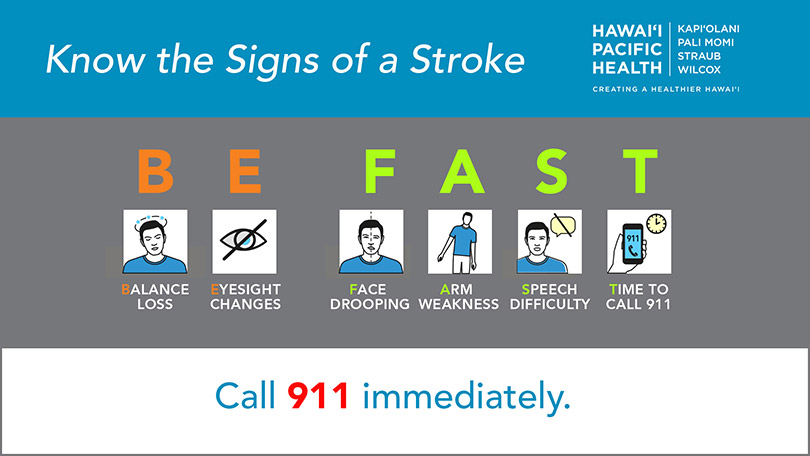Stroke is a Leading Cause of Death and Disability – But It Doesn’t Have to Be
Every 40 seconds, someone, somewhere in the United States, suffers a stroke.
That’s the same amount of time it takes to reply to an email, reheat a cup of coffee or post a selfie.
According to the American Heart Association (AHA) and American Stroke Association (ASA), stroke is the fifth leading cause of death but is the third leading cause in Hawaii.
Stroke also is the leading cause of adult disability in the U.S., with nearly 800,000 people suffering a new or recurrent stroke each year.
When It Comes to Stroke, It’s Important to BE FAST
Recognizing the symptoms and getting help quickly can make a difference in treatment and recovery.
It’s easy to remember the signs to look for with BE FAST.

- B = Balance Loss
Is there a sudden loss of balance or difficulty with coordination?
- E = Eyesight Changes
Is there a sudden change in vision, such as blurred or double vision? Or, is there a loss of vision in one or both eyes?
- F = Face Drooping
Does one side of the face droop? Is one side of the face numb? Ask the person to smile to test for drooping or loss of feeling.
- A = Arm Weakness
Is one arm weak or numb? Ask the person to raise both arms. Does one arm drift downward? Weakness is typically on one side of the body and may involve the leg as well.
- S = Speech Difficulty
Does the person slur when they speak? Do they have difficulty forming or understanding words? Ask the person to say a simple sentence, such as “My name is ____” or “I live in Hawaii.” Do they repeat the sentence correctly?
- T = Time to Call 911
If the person shows any of these signs, it's time to call 911.
During a stroke, every second counts. Call 911 immediately, even if the symptoms go away. Check the time so you’ll know when the first symptoms appeared. Early treatment leads to higher survival rates and lower disability rates.
Learn More About Stroke
Dr. Michael Lui on Hawaii News Now Sunrise
Dr. Michael Lui, Hawaii Pacific Health Medical Group neurologist and section chief of neurology at Pali Momi Medical Center, appeared on Hawaii News Now’s Sunrise to explain how stroke and hypertension, or high blood pressure, are related.
It's Estimated 80% of Strokes are Preventable
The most common risk factors for stroke – high blood pressure, diabetes, high cholesterol and smoking – can be controlled or prevented with lifestyle changes. Work with your primary care physician on steps to manage your individual needs.
8 Mindfulness Exercises That Also Reduce Stress
High blood pressure is a leading risk factor for stroke. Practicing mindfulness can reduce stress and improve overall health but just like any habit, needs to be practiced regularly to experience its full benefits.
Be Smart About Brain Health
The body gets a lot of attention when it comes to aging. But to stay healthy and independent well into your golden years, you also need to take proper care of your brain. Help both your mind and body age gracefully with these tips from a neurologist.
Your Grocery Guide for a Healthier Heart
A heart-healthy diet – one filled with fresh, wholesome food choices and low in highly processed foods – is shown to reduce the risk of stroke. Download a printable list for your next trip to the market.
Don't Let Your Lung Health Go Up in Smoke
Smoking doesn’t just put you at risk for lung cancer – it also is a leading risk factor for stroke. Learn how to extinguish a smoking habit with advice from a pulmonologist.
Our Certified Primary Stroke Centers Follow Best Practices for Stroke Care
A Higher Level of Care

Pali Momi Medical Center, Straub Benioff Medical Center and Wilcox Medical Center have earned The Joint Commission’s Gold Seal of Approval® and the American Heart Association/American Stroke Association’s Heart-Check mark for Advanced Certification for Primary Stroke Center.
The Gold Seal of Approval® and the Heart-Check mark represent symbols of quality from their respective organizations.
The certification recognizes centers that follow the best practices for stroke care. Certified primary stroke centers:
- Use a standardized method of delivering care.
- Support patient self-management activities.
- Tailor treatment and intervention to individual needs.
- Promote the flow of patient information across settings and providers, while protecting patient rights, security and privacy.
- Analyze and use standardized performance measure data to continually improve treatment plans.
- Demonstrate their application of and compliance with clinical practice guidelines published by the AHA/ASA or equivalent evidence-based guidelines.




